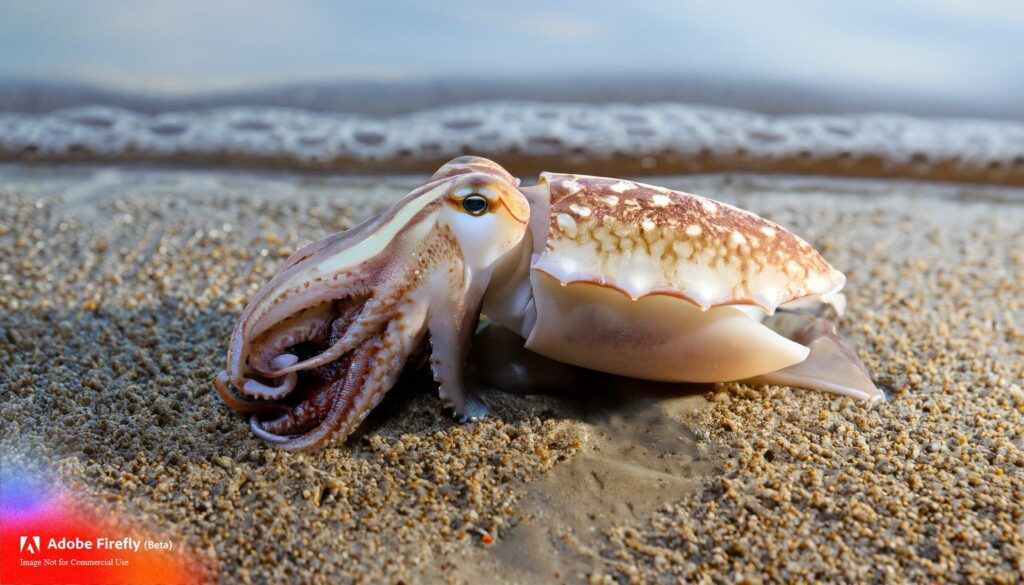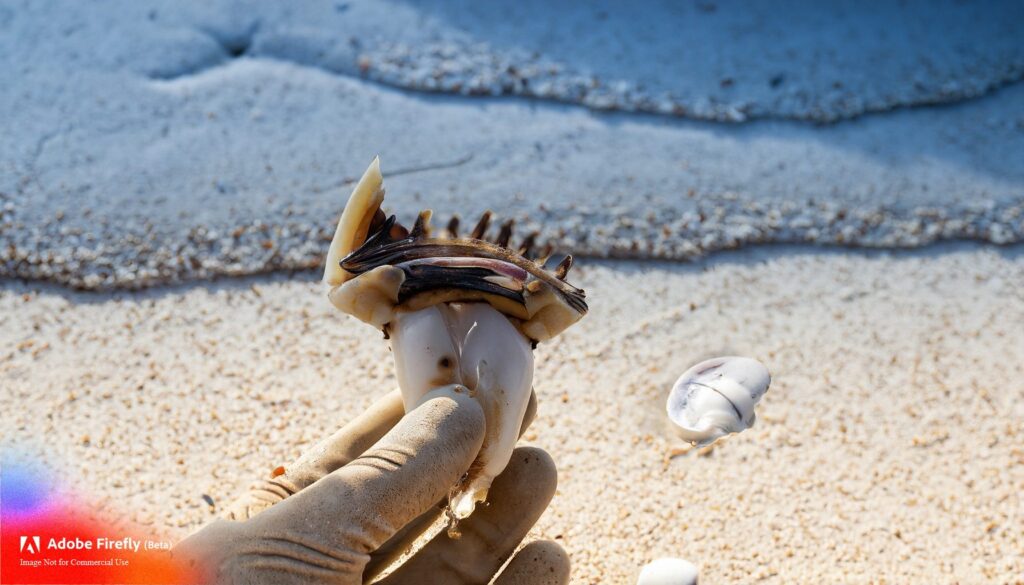
Imagine a calm beach day, the gentle waves, the warm sun, the scattered seashore treasures, and Cuttlefish bones lying around. Have you ever wondered if those strange cuttlefish bones are good for the local birds?
Join us in this article to explore the connection between Birds and Cuttlefish. And even if Cuttlebones are healthy, we will uncover whether picking them from the beach for birds is safe.
Cuttlebones, the bone-like things, wash up after the cuttlefish leave. People think they might help the birds, but how?
Let’s find out if giving these ocean gifts to our feathered friends is a nice idea or a strange one.
What are Cuttlefish?
Cuttlefish are one of the many creatures from the sea. They are like far cousins to squids and octopuses. Cuttlefish are soft from the outside with a special inside shell called a cuttlebone. These marine creatures have big eyes that help them hunt. Cuttlefish are known to change their color and texture and can actually talk with each other.
But why (how) are they commonly found on the beach?
It is pretty obvious to spot cuttlebones on the beach. Cuttlebones are like the inner shells of Cuttlefish that help them float. When Cuttlefish die, these cuttlebones come loose and often end up on the shore. That is how it is very common to find Cuttlebones on the beach. These bones are usually white, lightweight, and sort of spongy.
While some people collect Cuttlebones to create art and craft out of the same, others collect them to feed to pet birds. Either hunt them as nature’s souvenir or as a treat for your pet birdy next time whenever you are at the beach.

Can You Give Birds Cuttlefish From The Beach?
Yes, it is absolutely OK to give birds Cuttlefish from the beach. However, there’s a catch- Never give Cuttlebones to your birds directly from the beach. While these fish bines are great for birds, the little snack that provides them calcium directly from the beach isn’t safe.
Here’s why you shouldn’t give cuttlebones directly from the beach to your bird:
- Cuttlebones found on the beach might be exposed to pollutants or contaminants like salt, oil, or chemicals that can be harmful to your bird.
- Beach Cuttlebones might be from unknown sources. Determining if they are safe for your bird to consume is slightly tricky.
- Cuttlebones on the beach could harbor bacteria, parasites, or other microorganisms that could make your bird sick.
- Cuttlebones found in the wild can vary in quality. They might not provide the necessary nutrients your bird needs.
- Beach collected Cuttlebonescould be dried out and brittle. They may not offer the same benefits as fresh, properly prepared ones.
- Store-bought cuttlebones are typically cleaned, sterilized, and processed to ensure they are safe for pets. At the same time, beach-found cuttlebones lack this processing.
- Some coastal areas might have naturally occurring toxins or minerals that could be harmful to your bird.
- Unprocessed cuttlebones could have sharp edges or debris that might harm your bird’s mouth or digestive system.
- Store-bought cuttlebones are often fortified with additional minerals and nutrients beneficial for your bird’s health. However, the ones’ found on the beach may lack the same.
- Without proper preparation, beach-found cuttlebones might not provide the same benefits to your bird’s beak and overall health.
Just make sure the cuttlebone is clean and free from any chemicals or contaminants before offering it to the birds.

Do birds naturally consume Cuttlefish in their diet?
NO, Cuttlebones or Cuttlefish aren’t a part of birds’ regular diet. Birds are primarily wild (or free-flowing), and most of their species are found on land. Cuttlefish are marine animals; therefore, naturally, they aren’t part of birds’ diet.
The cuttlebone, which is the internal shell of the Cuttlefish, can be beneficial for birds due to its calcium content. In their natural habitat, birds obtain their nutrients from various natural food sources, including seeds, fruits, insects, etc. However, when obtaining these nutrients becomes a challenge in captivity, Cuttlebones are offered to birds.
When offered to pet birds, the cuttlebone serves as a calcium supplement and a way to keep their beaks healthy and trimmed. It’s not a natural food source for them, but the minerals in the cuttlebone can support their overall health, especially for birds that might not have access to a diverse range of foods.
So, while birds don’t naturally consume Cuttlefish, providing cuttlebones as a supplement can be helpful for their well-being, especially in captivity.
Nutritional Value and Advantages of Cuttlefish for Birds
Nutritional Value of Cuttlefish for Birds:
- Cuttlefish cuttlebones are a rich source of calcium. Including it in birds’ diet ensure strong bones and healthy eggshell formation.
- Cuttlebones are rich in essential minerals like magnesium, zinc, and trace elements, all contributing to overall avian health.
- Cuttlebones’ texture provides a natural way for birds to trim and maintain their beaks, preventing overgrowth.
Advantages of Cuttlefish for Birds
- By nibbling on Cuttlebones, birds can self-regulate their calcium, thus reducing the risk of calcium deficiencies.
- Chewing Cuttlebones encourage adequate calcium intake and support skeletal development, preventing conditions like brittle bones in birds.
- The calcium levels from cuttlebones are crucial for producing strong and healthy eggshells in breeding birds.
- Chewing on cuttlebones helps birds naturally manage their beak length, ensuring proper eating and grooming.
However, Cuttlebones aren’t a means of regular diet for birds, but only a supplement. Offer it in moderation, alongside a well-balanced bird diet, clean water, and appropriate treats.
Always ensure the cuttlefish products are clean and safe for consumption.
risks associated with birds consuming Cuttlefish from the beach
Although Cuttlebones benefit birds’ health, they may also carry some potential risks. For instance:
- Cuttlebones found on the beach aren’t safe to directly feed the birds. Such Cuttlebones are probably exposed to chemicals and pollutants or may have microorganisms present in them. Ingesting contaminated cuttlebones could pose health risks to birds.
- Cuttlebones washed up on the beach might have absorbed saltwater. Consuming them may lead to increased salt content. It is important to learn that high salt levels are harmful to birds, especially their kidneys. DID KNOW KNOW? Salt is an essential mineral in Birds’ diet.
- Cuttlefish bones found on the shore could harbor parasites or microorganisms that may be harmful to birds if ingested.
- While calcium is important for birds, excessive consumption of cuttlebones could lead to an imbalance in their diet. Birds that have access to a diverse and well-balanced diet might not need additional calcium supplements.
- If the cuttlebone is not properly cleaned, it may have sharp edges or impurities that might injure a bird’s beak or digestive system.
To mitigate these risks, offering commercially prepared and cleaned cuttlebones intended for bird consumption is recommended. Also, choose high-quality sources and avoid giving birds cuttlefish bones directly from the beach to ensure their well-being.
What can I give to my birds instead of Cuttlebones? Cuttlefish (Bone) substitute for Birds
There are alternative options you can provide to your birds if you’re looking for substitutes for cuttlebones. For instance:
- Mineral Blocks: A good source of essential minerals, including calcium. Mineral blocks for birds come in different sizes and flavors.
- Calcium-Rich Foods: Besides Cuttlebone, other food sources that offer Calcium to birds include dark leafy greens such as kale, collard greens, broccoli, and almonds (in moderation). Fortified bird pellets are also a nice option to go by. These can supplement their calcium intake.
- Crushed and baked eggshells can be a great natural calcium source. Or Crushed oyster shells are another calcium-rich option.
- Cuttlefish-Flavored Treats: Some pet stores offer cuttlefish-flavored treats designed to provide the benefits of cuttlebones without the actual shell.
- Commercial Calcium Supplements: There are liquid and powdered calcium supplements formulated for birds.
- Avian Grit: Grit made of crushed shells, minerals, and small stones can aid digestion and provide essential minerals. Please Note: Since not all bird species require grit, so consult with a veterinarian.
Remember that birds’ dietary needs can vary based on species, age, and health condition.
Wrapping up…
Overall, giving birds Cuttlefish directly from the beach might not be the best bet due to possible pollution and human interference. However, you can always pick Cuttlebones from the beach, clean them nicely and then offer them to the birds. Or, instead, buy some from a pet store.
But since there are cool alternatives like special mineral blocks, calcium-packed foods, and even eggshells, leave all your worries.

Hi, There and Welcome to BirdsNews.com, is here to help you learn and care about pet birds. and this blog is a journal of everything I’ve learned.
